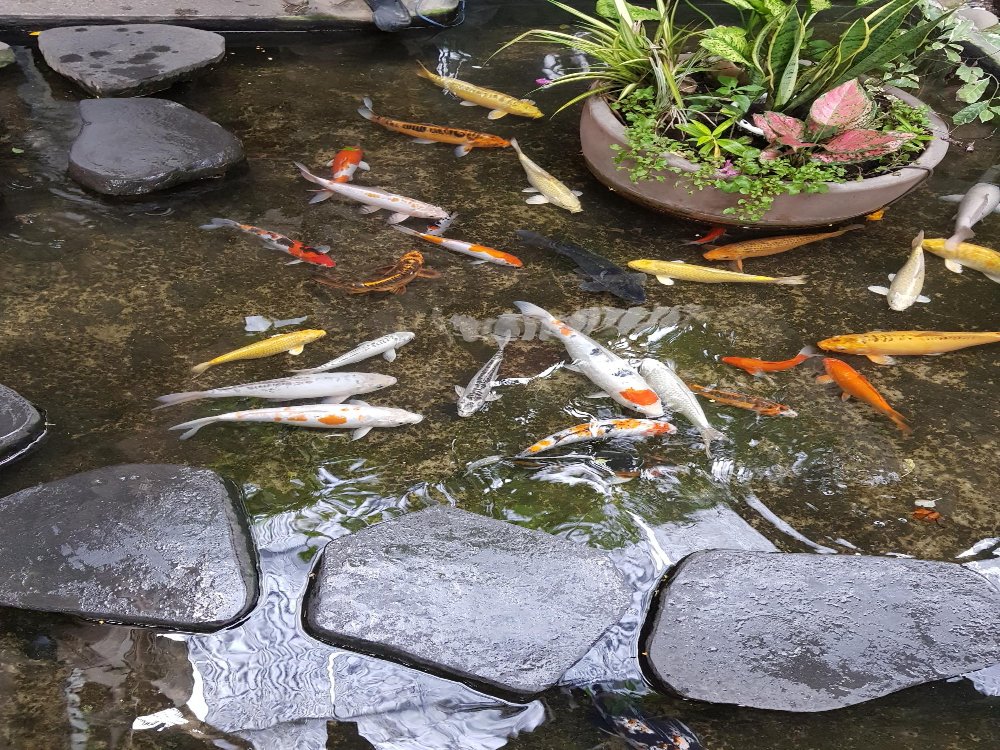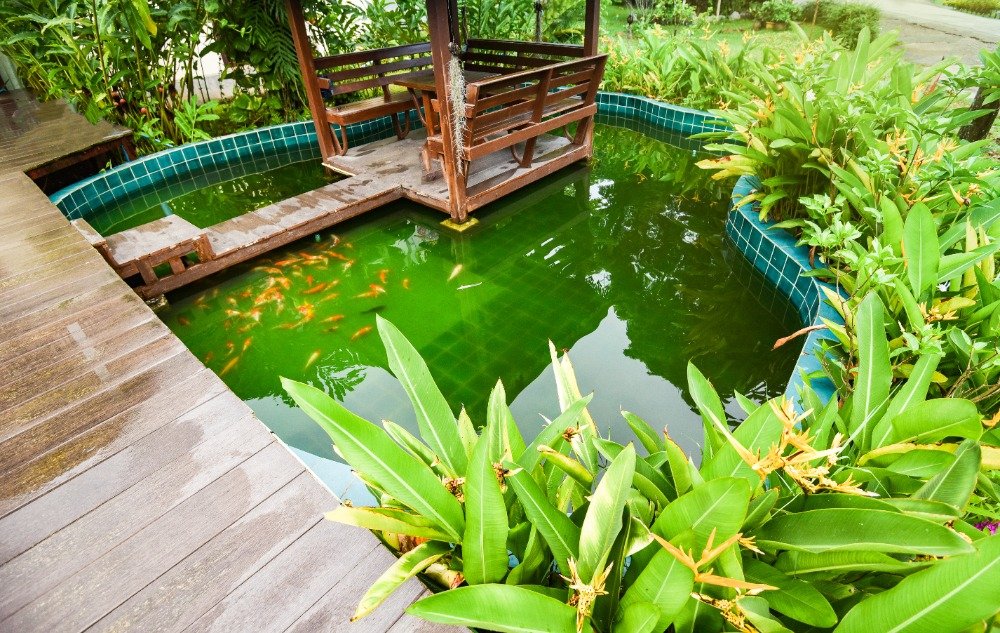
DIY Koi Pond: Transform Your Backyard into a Tranquil Oasis
DIY Koi Pond, Koi ponds are the perfect blend of beauty, tranquility, and functionality, turning any backyard into a slice of paradise. If you’ve ever dreamed of having your own koi pond but thought it might be too complex or expensive, think again! This step-by-step guide will show you how to build a stunning koi pond from scratch, even if you’re a complete beginner. Let’s dive in and create a serene water feature your koi will love.
DIY Koi Pond, Planning Your Koi Pond: The Foundation of Success

Choosing the Perfect Location
Selecting the right spot is crucial for your pond’s success. Aim for a location that gets 4–6 hours of sunlight daily. Too much sunlight can lead to excessive algae growth, while too little can hinder aquatic plant growth. Avoid placing the pond near trees to prevent debris accumulation.
Determining the Right Size and Depth
Koi need ample space to thrive. A depth of at least 3 feet is essential to regulate temperature and protect fish from predators. For surface area, aim for 50–100 square feet depending on how many koi you plan to keep.
Setting a Realistic Budget
DIY koi ponds can range from $500 to over $5,000 depending on the size and features. Budgeting helps you make decisions about materials, equipment, and aesthetic additions.
Gathering Essential Tools and Materials
Before you begin, collect all necessary items. You’ll need:
- Pond liner (preferably EPDM rubber)
- Pump and filtration system
- Rocks and pebbles for decoration and stabilization
- Aquatic plants for aesthetics and oxygenation
- Basic tools: shovels, a spirit level, and measuring tape
Designing Your DIY Koi Pond
Sketching Your Pond Layout
Begin with a rough sketch of your pond. Decide on the shape—oval, kidney-shaped, or natural—and plan for areas with shallow and deep zones. Include locations for a waterfall, plants, or a seating area.
Selecting a Filtration System
Proper filtration is vital to maintaining water clarity and koi health. Choose between biological, mechanical, or UV filtration systems for optimal results. Consider a combination for the best water quality.
Incorporating Aesthetic Features
A koi pond isn’t just functional; it’s a visual masterpiece. Add features like cascading waterfalls, underwater lighting, and strategically placed rocks to enhance its appeal.
Building Your DIY Koi Pond: A Step-by-Step Guide
Step 1: Marking and Excavating
Outline your pond’s shape with spray paint or rope. Start digging according to your plan, ensuring gradual slopes for easy maintenance and stability. For added depth and diversity, create shelves for plants at different levels.
Step 2: Installing the Pond Liner
Lay a geotextile fabric to protect the liner from sharp objects, then position your EPDM rubber liner. Ensure it fits snugly into all corners and secure the edges with decorative stones.
Step 3: Setting Up the Filtration and Pump
Install the pump and filter before filling the pond with water. The pump should be placed at the pond’s lowest point for effective water circulation. Connect it to the filtration system, ensuring all pipes are sealed.
Step 4: Filling the Pond with Water
Fill the pond slowly to prevent liner shifts. Use a dechlorinator to make the water safe for fish. Test pH, ammonia, and nitrite levels to ensure optimal water quality.
Adding Life to Your DIY Koi Pond: Introducing Koi and Plants
Selecting Healthy Koi Fish
Buy your koi from reputable dealers to ensure they are disease-free. Popular varieties like Kohaku, Showa, and Butterfly Koi are great choices for beginners.
Acclimating Koi to Their New Environment
Float their transport bag in the pond for 20–30 minutes to equalize temperatures before releasing them.
Choosing Aquatic Plants
Plants not only beautify your pond but also maintain a balanced ecosystem. Include:
- Floating plants like water lettuce and hyacinth
- Submerged plants such as anacharis for oxygenation
- Marginal plants like cattails for edge decoration
Enhancing the DIY Koi Pond Beauty
Decorative Elements
Add stepping stones, driftwood, or sculptural elements to make your pond a true centerpiece. Submersible LED lights can create a magical ambiance at night.
Creating Movement with Water Features
Incorporate waterfalls or fountains for soothing sounds and improved oxygen levels.
Caring for Your DIY Koi Pond
Routine Maintenance
- Skim the surface daily to remove debris
- Perform partial water changes weekly
- Clean filters monthly to maintain efficiency
Managing Algae Growth
Use natural methods like barley straw extract or install UV clarifiers to keep algae in check.
Seasonal Adjustments
- Winter: Use a pond heater to prevent freezing and maintain oxygen flow.
- Summer: Add shade structures and aerators to keep water temperatures stable.
The Benefits of a DIY Koi Pond
Koi ponds offer numerous advantages, from stress relief to boosting property value. Watching colorful koi glide gracefully through clear water is a therapeutic experience. Plus, these ponds attract beneficial wildlife, adding to your backyard’s biodiversity.
FAQs
- What’s the ideal size for a koi pond?
Aim for a pond that holds at least 1,000 gallons of water and is 3–5 feet deep. - Can I build a koi pond on a budget?
Absolutely! You can create a functional and beautiful koi pond for as little as $500 by using cost-effective materials and DIY techniques. - Do koi ponds require constant maintenance?
While they need regular care, modern filtration systems and automated devices can simplify maintenance. - How many koi can I keep in my pond?
A general rule is one koi per 250 gallons of water. Overcrowding can lead to health issues. - What’s the best filtration system for koi ponds?
A combination of biological, mechanical, and UV filters ensures optimal water quality.
You may also like
- https://giobelkoicenter.com/neon-koi-fish/
- https://giobelkoicenter.com/showa-koi-fish/
- https://giobelkoicenter.com/backyard-koi-pond-ideas/
- https://giobelkoicenter.com/do-people-eat-koi-fish/
- https://giobelkoicenter.com/how-to-protect-koi-fish-from-predators/
- https://giobelkoicenter.com/koi-fish-garden/
Table of Contents
Passionate about fish keeping since elementary school in the 1980s, Giovanni Carlo has dedicated countless hours to collecting and breeding a diverse array of ornamental freshwater fish. From vibrant guppies and majestic koi to striking bettas and classic goldfish, he continues to explore the fascinating world of aquatics, sharing knowledge and enthusiasm with fellow fish enthusiasts.